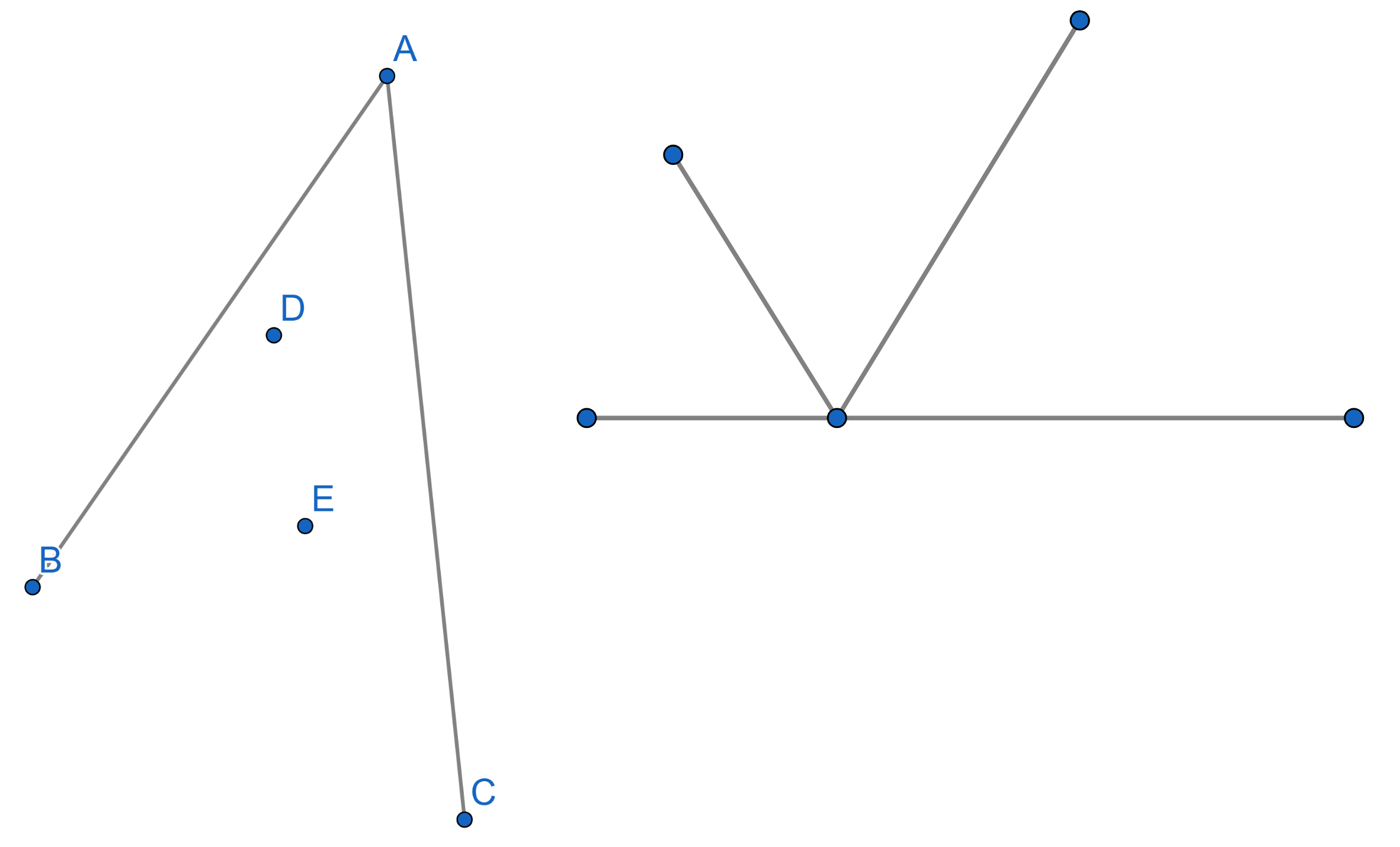Problems
In how many ways can \(\{1, . . . , n\}\) be written as the union of two sets? Here, for example, \(\{1, 2, 3, 4\}\cup\{4, 5\}\) and \(\{4, 5\}\cup\{1, 2, 3, 4\}\) count as the same way of writing \(\{1, 2, 3, 4, 5\}\) as a union.
Prove for any natural number \(n\) that \((n + 1)(n + 2). . .(2n)\) is divisible by \(2^n\).
Between two mirrors \(AB\) and \(AC\), forming a sharp angle two points
\(D\) and \(E\) are located. In what direction should
one shine a ray of light from the point \(D\) in such a way that it would reflect off
both mirrors and hit the point \(E\)?
If a ray of light comes towards a surface under a certain angle, it is
reflected with the same angle as on the picture.

Let \(a\), \(b\) and \(c\) be the three side lengths of a triangle. Does there exist a triangle with side lengths \(a+1\), \(b+1\) and \(c+1\)? Does it depend on what \(a\), \(b\) and \(c\) are?
There is a triangle with side lengths \(a\), \(b\)
and \(c\). Can you form a triangle with
side lengths \(\frac{a}{b}\), \(\frac{b}{c}\) and \(\frac{c}{a}\)? Does it depend on what \(a\), \(b\)
and \(c\) are? Give a proof if it is
always possible or never possible. Otherwise, construct examples to show
the dependence on \(a\), \(b\) and \(c\).
Recall that a triangle can be drawn with side lengths \(x\), \(y\)
and \(z\) if and only if \(x+y>z\), \(y+z>x\) and \(z+x>y\).
There is a triangle with side lengths \(a\), \(b\)
and \(c\). Does there exist a triangle
with side lengths \(|a-b|\), \(|b-c|\) and \(|c-a|\)? Does it depend on what \(a\), \(b\)
and \(c\) are?
Recall that a triangle can be formed with side lengths \(x\), \(y\)
and \(z\) if and only if all the
inequalities \(x+y>z\), \(y+z>x\) and \(z+x>y\) hold.
There is a triangle with side lenghts \(a\), \(b\) and \(c\). Does there exist a triangle with sides of lengths \(a^2+bc\), \(b^2+ca\) and \(c^2+ab\)? Does it depend on the values of \(a\), \(b\) and \(c\)?
Now there are finitely many infinitely long buses with seats numbered as \(1,2,3,...\) carrying infinitely many guests each arriving at the full hotel. Now what do you do?
How about infinitely many very long buses with seats numbered \(1,2,3...\), each carrying infinitely many guests, all arriving at the hotel. Assume for now that the hotel is empty. But that seems like a lot of guests to accommodate. What should you do?
The whole idea of problems with Hilbert’s Hotel is about assigning numbers to elements of an infinite set. We say that a set of items is countable if and only if we can give all the items of the set as gifts to the guests at the Hilbert’s hotel, and each guest gets at most one gift. In other words, it means that we can assign a natural number to every item of the set. Evidently, the set of all the natural numbers is countable: we gift the number \(n\) to the guest in room \(n\).
The set of all integers, \(\mathbb{Z}\), is also countable. We gift the number \(n\) to the guest in room \(n\). Then we ask everyone to take their gift and move to the room double their original number. Rooms with odd numbers are now free (\(1, 3, 5, 7, \dots\)). We fill these rooms with guests from an infinite bus and gift the number \(-k\) to the guest in room \(2k+1\). Yes, that’s right: the person in the first room will be gifted the number \(0\).
Prove now that the set of all positive rational numbers, \(\mathbb{Q}^+\), is also countable. Recall that a rational number can be represented as a fraction \(\frac{p}{q}\) where the numbers \(p\) and \(q\) are coprime.